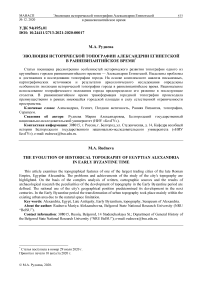Эволюция исторической топографии Александрии Египетской в ранневизантийское время
Автор: Руднева М.А.
Журнал: Материалы по археологии и истории античного и средневекового Причерноморья @maiask
Рубрика: История
Статья в выпуске: 12, 2020 года.
Бесплатный доступ
Статья посвящена рассмотрению особенностей исторического развития топографии одного из крупнейших городов ранневизантийского времени - Александрии Египетской. Выделены проблемы и достижения в исследовании топографии города. На основе комплексного анализа письменных, картографических источников и результатов археологического исследования определены особенности эволюции исторической топографии города в ранневизантийское время. Рациональное использование географического положения города предопределило его развитие в последующие столетия. В ранневизантийское время трансформация городской топографии происходила преимущественно в рамках имеющейся городской площади в силу естественной ограниченности пространства.
Александрия, египет, поздняя античность, ранняя византия, топография, серапеум
Короткий адрес: https://sciup.org/14118251
IDR: 14118251 | DOI: 10.24411/2713-2021-2020-00017
Список литературы Эволюция исторической топографии Александрии Египетской в ранневизантийское время
- Белов А.А. 2009. Большой порт греко-римской Александрии по современным археологическим данным. В: Шеркова Т.А. (ред.). Культура Египта и стран Средиземноморья в древности и средневековье. Mосква: ЦЕИ РАН, 32—53.
- Зайцева И.В. 2018. Особенности исторической топографии Александрии Египетской. НВБелГУ 2, 222—226.
- Петрунина Ж.В. 2008. Египетский поход Наполеона: опыт европейского правления на Ближнем Востоке. Ученые записки Российского государственного социального университета 1(57), 115— 122.
- Ребизов О.Г. 2011. Археологические исследования в Александрии Египетской: проблемы и перспективы. Христианское чтение 5, 119—137.
- Baity J.-C. 1983. Le 'bouleuterion' de l'Alexandrie severienne. Études et Travaux 13, 7—12.
- Damir M. 2018. Uncovering the Morphology of Kom ad-Dikka in Alexandria. Heritage 1, 273—288.
- Empereur J.-Y. 1999. Alexandria Rediscovered. London: British Museum Press.
- Fraser P.M. 1972. Ptolemaic Alexandria. Vol. I—III. Oxford: Clarendon Press; New York: Oxford University Press.
- Haas C. 2001. Alexandria and the Mareotis Region. In: Burns T.S, Eadie J.W. (eds.). Urban Centers and Rural Contexts in Late Antiquity. Michigan: Michigan State University Press, 47—62.
- Haas C. 1997. Alexandria in Late Antiquity: topography and social conflict. Baltimore; London: Johns Hopkins University Press.
- Hesse A. 2002. L'Heptastadium d'Alexandrie (Egypte). Alexandrina 2. Etudes Alexandrines 6, 191—273.
- Humphrey J. 1986. Roman Circuses: Arenas for Chariot Racing. Berkeley: University of California Press.
- Kiss Z. 1990-1992. Les auditoria romains tardifs de Kom el-Dikka (Alexandrie). Acta Antiqua Academiae Scientiarum Hungaricae 33, 331—336.
- Kol^taj W. 1992. Imperial Baths at Kom el-Dikka. Alexandrie 6, 179—186.
- Kolataj W. 1983. Recherches architectoniques dans les thermes et le theatre de Kom el-Dikka a Alexandrie. In: Grimm G., Heinen H., Winter E. (eds.) Das romisch-byzantinische Agypten 2. Mainz: P. von Zabern, 189—194 (Aegyptiaca Treverensia).
- Kolataj W., Majcherek G., Parandowska E. 2007. Villa of the Birds: The Excavation and Preservation of the Kom al-DikkaMosaics. Cairo: The American University in Cairo Press.
- Kyriakos S., Bianchi R.S. 2012. Alexandrian sculpture in the Graeco-Roman Museum. Alexandria: Bibliotheca Alexandrina.
- Lorenz S. 1981. In memoriam. RocznikMuzeum Narodowego w Warszawie 25, 5—52.
- Mahaffy J.P. 1899. A History of Egypt under the Ptolemaic Dynasty. London: Methuen & Co.
- Mahmoud S. 2012. The development of archaeological and historical museums in Egypt during the nineteenth and twentieth centuries: Imperialism, Nationalism, UNESCO patronage, and Egyptian Museology today. PhD Thesis. Lubbock.
- Majcherek G. 2007. The Auditoria on Kom el-Dikka: A Glimpse of Late Antique Education in Alexandria. In: Gagos T. (ed.). Proceedings of the 25th International Congress of Papyrology. Ann Arbor, July 29 — August 4, 2007. Ann Arbor: Scholarly Publishing Office, 471—484.
- Makowiecka E. 1971. The numbering of the seating places at the Roman theatre of Kom el-Dikka in Alexandria. Acta Conventns XI, 479—483.
- McKenzie J. 2003. Glimpsing Alexandria from archaeological evidence. Journal of Roman Archaeology 16, 35—63.
- Ndroutos Bey T.D. 1888. L'Ancienne Alexadrie. Etude archeologique and topographique. Paris: Ernest Leroux.
- Rodziewicz M. 2009. Ancient Baths in Alexandria. In: Boussac M.-Fr, Fournet Th., Redon B. (eds.). Le bain collectif en Égypte, origine évolution et actualités des pratiques. Actes du colloque Balnéorient. Alexandrie, 1-4 décembre 2006. Cairo: Institut Français d'Archéologie Orientale; Institut Français du Proche-Orient, 191—201 (Etudes Urbaines 7).
- Rowe A. 1946. Discovery of the Famous Temple and Enclosure of Serapis at Alexandria: With an explanation of the enigmatical inscriptions on the Serapeum plaques of Ptolemy IV (Plàques bilingues de Ptolémée IV). Supplément aux Annales du Service des antiquités de l'Égypte. Cahier No. 2. Caire: Imprimerie de I'Institut français d'archéologie orientale.
- Seif El-Din M. 2010. The Greco-Roman Museum of Alexandria, Past, Present, and Future. Bibliotheca Alexandrina Alex Med Newsletter 7, 7—9.
- Fraser P.M. (ed.). 1951. Syriac Notitia Urbis Alexandrinae. Journal of Egyptian Archaeology 37, 103—104.
- Watts E.J. 2006. City and School in Late Antique Athens and Alexandria. The Transformation of the Classical Heritage 41.
- Watts E.J. 2010. Riot in Alexandria: Tradition and Group Dynamics in Late Antique Pagan and Christian Communities. Berkeley: University of California Press.
- Weiss Z., Talgam R. 2002. The Nile Festival Building and its mosaics. In: Humphrey J.H. (ed.). The Roman and Byzantine Near East. Vol. 3. Late-Antique Petra. Ann Arbor: Scholarly Publishing Office, 67—72 (Journal of Roman Archaeology. Supplementary Series 49).


